I’ve talked to sales leaders who’ve generated millions in qualified pipeline for companies like Bolt, Dell, and Google — through cold outreach strategies.
In those conversations, I discovered something counterintuitive: the tactics that worked best weren’t the most creative or complicated.
They were the ones that hit at the right moment, spoke to the right problem, and matched where the prospect actually was in their journey. Sounds simple, but it’s not.
In this article, I’ll walk you through 8 strategies that consistently drive replies and meetings—plus the templates and timing to execute each one. Then I’ll share the one principle that makes all of them work.
Let’s start with the strategies:
- Warm up conference prospects before you meet them
- Stand out with handwritten letters
- Send messages from your executive’s email
- Use multi-channel sequences to stay relevant
- Host lunch-and-learns that build trust before the pitch
- Gain access to the buying committee with multithreading
- Contact LinkedIn event attendees
- Send cold outreach after a vital event
Watch Simon Stanisz, sales advisor for Google and Bolt, share how to create a cold outreach strategy that books more meetings.
1. Warm up conference prospects before you meet them
Best time to use: When attending conferences and trade shows is a part of your GTM strategy.
Most B2B salespeople attend conferences and simply walk up to prospects at a booth and launch their offer. That system rarely works, even for those who are highly persuasive.
Want to know what works better? Reaching out beforehand. It changes everything. That early touch builds familiarity, so when you finally meet in person, you’re not starting from zero.
You could reach out to set up a coffee chat, suggest a quick booth visit, or even invite them to a private dinner—provided you approach prospects without sounding transactional, pushy, or salesy.
How to execute
There are two approaches:
- Option 1: Search LinkedIn for posts about the event you’re attending. Look for people from your ICP who posted or engaged, then send a short message.

- Option 2: Visit the event’s LinkedIn page and check for recent posts promoting the conference. Check the engagements, identify people who fit your ICP, research their role and challenges, and reach out with a personalized note.
Do this 1-4 weeks before the conference, when attendees are finalizing schedules. Don’t pitch—suggest a conversation about a topic related to your product.

For high-value accounts, go further: invite them to a private dinner or coffee chat near the venue.
Here’s a message template you can use:
Connection Request: Hey {{first_name}}, noticed you’re also attending {{event_name}} this year. I’ve been chatting with a few other {{ICP_role}}s about {{topic or pain relevant to your product, e.g., what’s actually working in outbound right now}} — would be great to swap notes while we’re there.
Follow-up (post-accept): Thanks for connecting, {{first_name}}! I’m hosting a small group chat with a few {{ICP_role}}s during {{event_name}} about {{specific challenge, e.g., scaling outbound without spamming}}. Would you like me to send the invite?
2. Stand out with handwritten letters
Best time to use: To break through to high-value prospects who aren’t responding to digital outreach, or to re-engage cold prospects who’ve gone silent.
Because handwritten letters are so rare in B2B, they instantly stand out. Their personal and physical nature also bypasses digital fatigue and captures the attention of even the busiest executives.
How to execute
This works best when you’ve identified a specific trigger or insight about the prospect—a recent funding round, a job posting, a company announcement, or a problem you’ve noticed in their industry. That specificity makes them curious enough to actually read it, even though you’ve never connected before.
Keep it short—3-4 sentences:
- Mention the problem you discussed or observed.
- Tie it to an outcome they care about.
- End with a single next step.
- Be delivered to their workspace, not their home. That way, you keep the engagement professional.
To make the letter more effective and track if it was opened, print a small QR code at the end of the note that links to a 2-minute personalized video on YouTube or Loom. Use it to reintroduce yourself, restate the value, and invite further discussion.
Here’s a template you can use to execute this strategy:

3. Send messages from your executive’s email
Best time to use: When you have an exec with industry authority and a large audience.
Executives have something most SDRs don’t: trust equity. You can leverage this by using an email domain with their name to send cold outreach messages to high-ticket accounts your exec already has a connection with (probably via LinkedIn connections)
This will generate responses not only because of the trust equity, but also because the sender appears credible and busy enough not to waste time.
How to execute
Pull a list of people who follow or are connected to your executive on LinkedIn. Cross-match those names with your target account list to find overlap with high-priority accounts. If there is, prepare an outreach message that’s:
- Connected to something specific. Could be an event, a recent announcement, a shared connection with the exec, or previous conversations.
- Emotionally relevant (“noticed you recently expanded your team”) and logically compelling (“teams we work with are seeing faster onboarding”).
- Low-friction ask — “Worth a quick intro with our team?” instead of “Book a demo.”
This is a simple template you can customize:
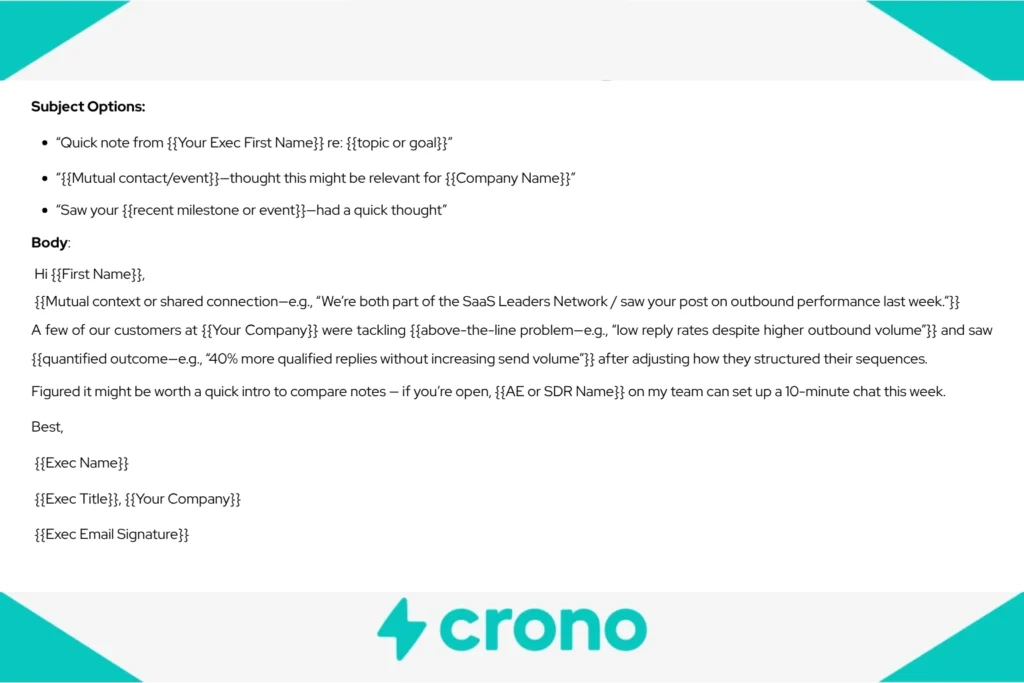
Pro tip: Always copy an SDR in CC, to make it easier to follow up later
4. Use multi-channel sequences to stay relevant
Best for: High-value accounts that need several interactions before engaging.
B2B prospects are typically very busy people. So, sometimes, when they don’t reply, it’s not that they are disinterested. In most cases, they just haven’t seen your message yet. That’s why spreading your outreach across email, LinkedIn, and calls increases your chances of getting a reply.
How to execute
Create a simple, repeatable process that spans multiple channels. Each touchpoint should build on the previous one, not repeat it.
Here’s a sample sequence with two emails, one call, and one LinkedIn touch:
- Email 1 → Personalized intro.
- Reference a real event, trigger, or referral to build relevance
- Briefly state your value proposition and outcome.
- Example: “Noticed your team recently expanded outbound — curious if you’re exploring ways to increase reply rates without adding more volume.”
- Reference a real event, trigger, or referral to build relevance
- Follow-up → Meeting bridge.
- Transition toward a soft call to action.
- Example: “Happy to share the framework our top clients use. Open to a quick 10-minute call this week?”
- Transition toward a soft call to action.
- Call → Only if they’ve opened or engaged.
- Use data from tools like Crono’s Live Feed to identify who’s shown interest.
- Keep it conversational — reference your earlier emails so it feels like a continuation, not a cold pitch.
- Use data from tools like Crono’s Live Feed to identify who’s shown interest.
- LinkedIn message → Light and value-based.
- Send after the call or as a re-engagement nudge.
- Example: “Hey {{first_name}}, shared this quick playbook on increasing reply rates — thought it might be useful for your team.”
- Send after the call or as a re-engagement nudge.
After your last touchpoint, pause the sequence for 1–2 weeks before circling back with a new angle or fresh value offer.
Keeping track of multiple touchpoints manually is time-consuming. See how Crono helps sales teams prospect and book meetings faster.
Want to see how Crono can execute your cold outreach strategy faster? Book a demo
5. Host lunch-and-learns that build trust before the pitch
Best for: Operating in crowded, undifferentiated markets.
Lunch-and-learns are a great way to stand out in a crowded market. Instead of pitching, host a short session where you teach prospects something valuable about a problem they’re facing. By the end, participants see you as an authority and already feel connected to your solution.
When they’re ready to buy, you’re the first person they think of.
How to execute
Based on the cold outreach value proposition you’ve created, choose a “hot-button” problem your target audience is currently facing. The title should promise a clear, specific solution without mentioning your product.
For example, if you sell sales engagement software:
- Problem: “Outbound teams are sending more messages than ever but getting fewer replies.”
- Session title: “3 Fixes to Boost Reply Rates Without Increasing Send Volume”
Then, invite prospects from non-competing companies at the same seniority level. Send reminders leading up to the event.
Next, structure the event to deliver value, not pitch: 20-30 minutes of insights, then 10 minutes of open discussion.
After the event, follow up with resources, then reach out again to those who engage to suggest exploring your solution. Remember to personalize your messages using the core principles of relevant outreach:
- Mention a recent signal (e.g., “noticed your team just expanded outbound”)
- Tie it to an outcome they care about (“we’re running a short session on improving reply quality without adding more volume”)
- End with a low-friction call to action
Download the free 4-step cold outreach template for hosting exclusive events.
6. Gain access to the buying committee with multithreading
Best for: After meeting with a contact at an enterprise company where the decision involves multiple stakeholders.
In B2B sales, one person rarely makes the decision. So, you can use your first meeting to qualify the lead and identify other decision-makers and influencers. Then, ensure every stakeholder understands your value from their own perspective.
How to execute
During the meeting, validate your value proposition and confirm it resonates. Identify other stakeholders involved, ask for introductions, and lock in a clear next step—ideally, a cold message requesting a follow-up meeting to go deeper.
Afterward, build two follow-up sequences:
- One for the people who attended the meeting, to reinforce alignment and keep momentum going.
- Another for those who didn’t attend, to extend your influence across the buying committee and ensure everyone understands your value.
Explore message templates to create follow-up sequences for meeting and non-meeting attendees.
7. Contact LinkedIn event attendees
Best for: Finding prospects with an active problem now.
Every day, there’s an event about the exact challenges your ICP is trying to solve. People attending have essentially raised their hand to say, “I have a problem in this area.”
That makes them perfect “could-buys”—they might not be looking for a vendor yet, but they’re aware of a problem your product solves.
How to execute
Search LinkedIn using your ICP’s core function (e.g., “sales,” “marketing”), then apply the Events filter. Choose events that align with your product’s value proposition.
For example, if you sell a sales automation platform, look for events about “scaling outbound,” “AI in sales,” or “HubSpot automation.”
Click Attend on relevant events to unlock the attendee list.
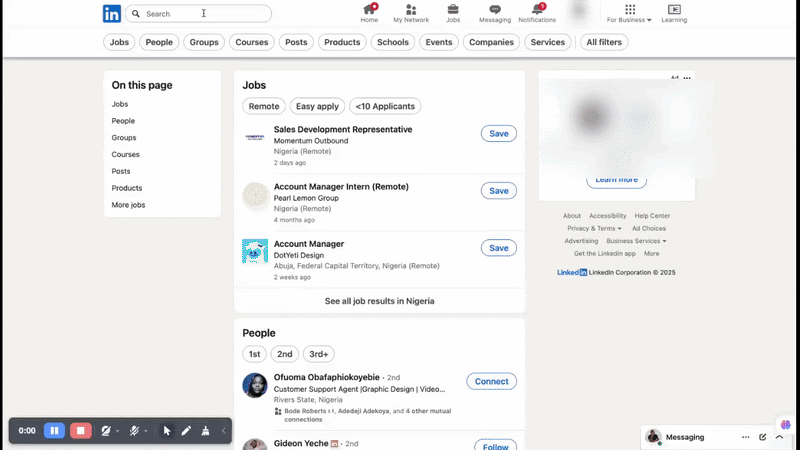
Note the event’s title and description—they reveal what attendees care about right now. That’s your outreach angle.
Next, send a non-salesy connection request to attendees or people engaging with the event post. The goal here is to build familiarity, not pitch:
Hey {{First Name}}, saw we’re both attending the {{Event Name}} session on {{Topic}} — looks like a great discussion. Would love to connect and swap notes afterward.

Pro tip: Instead of manually copying names or switching between tabs, use Crono’s Chrome Extension to import all event attendees — and anyone who engaged with the event post — directly into Crono or your CRM with one click.
8. Send cold outreach after a vital event
Best for: When there’s a company update like funding, product launch, leadership change, or hiring spree.
The key here is not to rush into a pitch. Instead, lead with an informed guess about what might be happening in the prospect’s world (a hypothesis) and invite them to correct you. This turns your outreach from a pitch into a conversation.
This works because it:
- Shows that you’ve done your homework,
- Lowers the social pressure to agree
- Gives the prospect an easy way to respond—even if it’s to disagree—which still starts a dialogue
How to execute
Identify the prospect’s current challenge based on a trigger event like a funding round, job postings, competitor news, or product launch. Formulate a hypothesis and incorporate it into your opening.
Imagine you’re targeting a VP of Sales at a SaaS company that just announced a $25M Series B and posted five new SDR roles on LinkedIn. That means they’re scaling and probably have a higher sales quota to hit.
So, your cold outreach message or script could be:
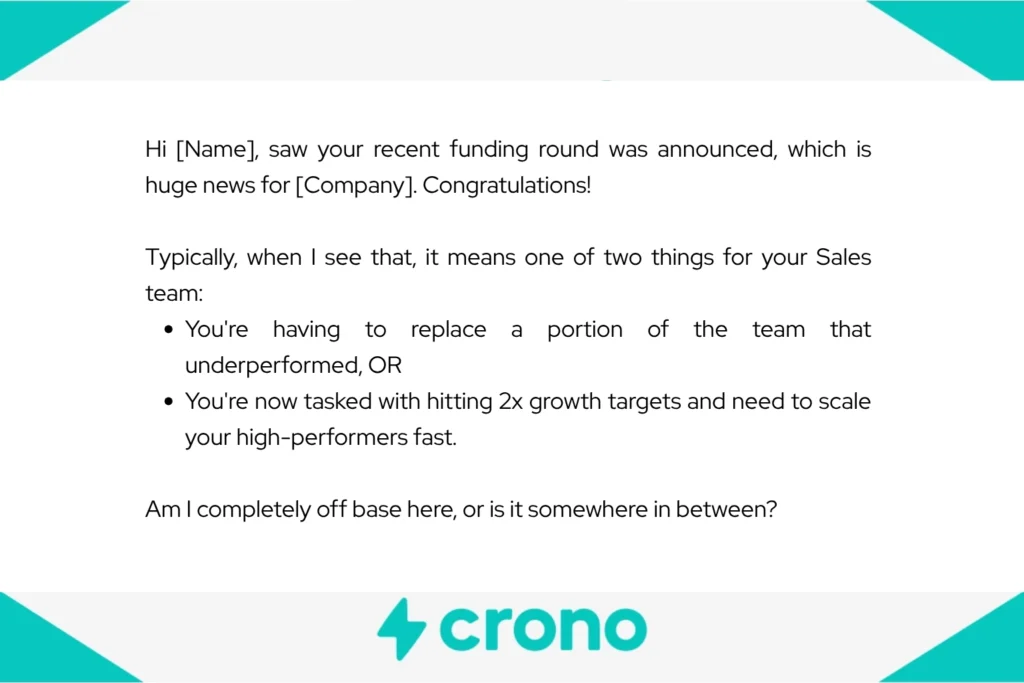
If they confirm or correct you, pivot to your solution:
Thanks for clarifying! The reason I ask is that we specialize in helping high-growth teams solve [The confirmed problem] without [common limitation]. Would you be open to a 5-minute video showing how?
Why These Strategies Actually Work
Each of these eight strategies improved reply rates, meetings booked, and deal velocity. But that was not because of clever templates or merge tags. It’s because each message hit at the right moment, spoke to the right problem, and matched the prospect’s context.
In other words, they were relevant.
Successful cold outreach optimizes for relevance, not just personalization
Here’s the distinction most people miss:
- Personalization = surface-level details about the prospect (name, company, job title)
- Relevance = speaking directly to their current situation (context, stage in journey, intent)
Cold outreach can be personalized and relevant. But it can also be personalized and still completely irrelevant—no matter how many custom variables you use.
Here’s the difference:
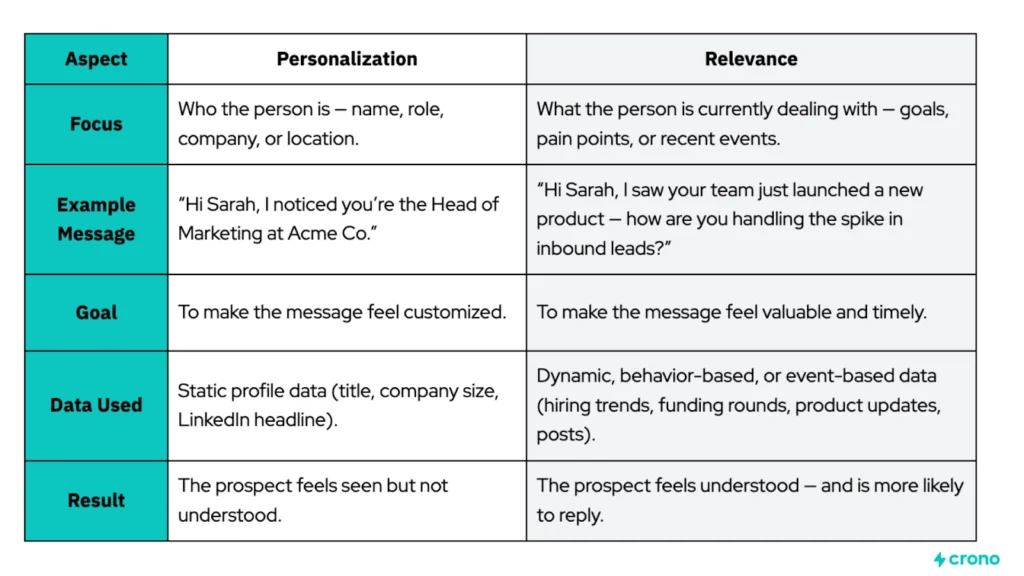
So how do you create relevance at scale?
The Four Building Blocks of Relevant Cold Outreach Strategy
They include:
- Right person: You’re reaching someone who is willing to buy.
- Right problem and framing: Your message speaks directly to a real pain, goal, or trigger event in their world.
- Right emotion and logic: Tugs on an emotion that pulls them over the buying line.
- Right value proposition: Delivers a promise relevant to the prospect’s current needs.
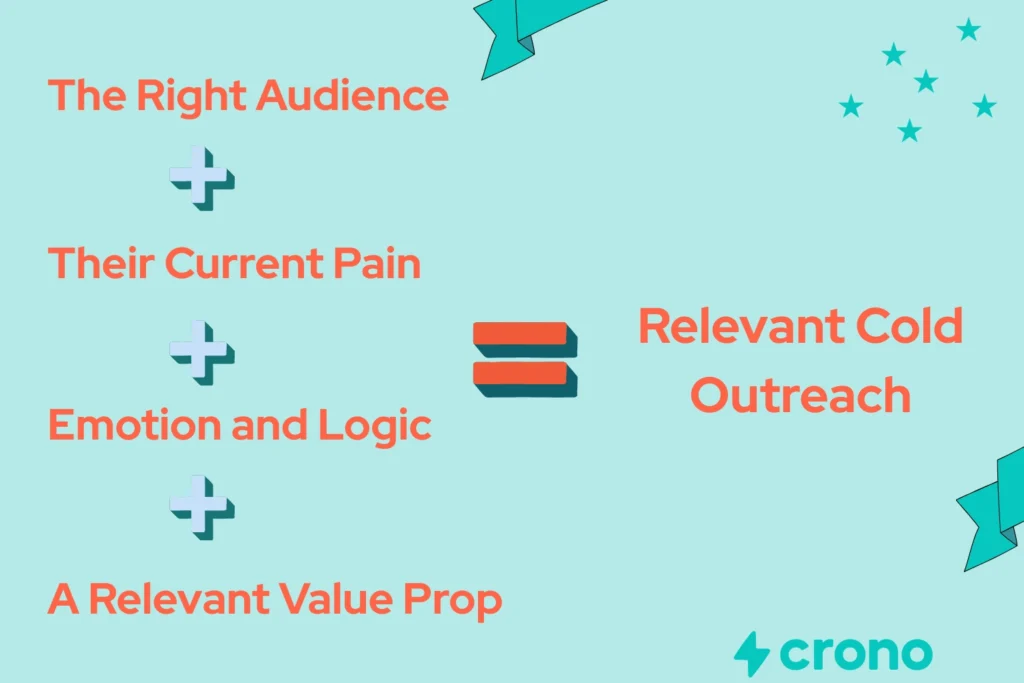
1. Targeted at ready-to-buy prospects
Not every account in your ICP is ready to buy now. Some are actively looking, others are curious but not urgent. A small group will never buy, no matter how long you nurture them.
That’s why I use a three-tier framework to segment prospects by buying readiness:
- Group A (5–10%) — Never buys. These will never buy from you, probably because of factors like your company’s size, certifications, and region. Find the shared characteristics of people who always say no and don’t buy from you, and disqualify them early.
- Group B (80–90%) — Could-buys (need the right nudge). They haven’t said yes or no. Use light, educational engagement (resources, LinkedIn comments, event invites) to nurture them. Monitor buying signals; when engagement spikes, move them to Group C.
- Group C (5–10%) — Always-buys. They have a live problem and need a solution now. Some find you through SEO or social. Others you find by knocking on the right doors with the right message. Spend time here first.
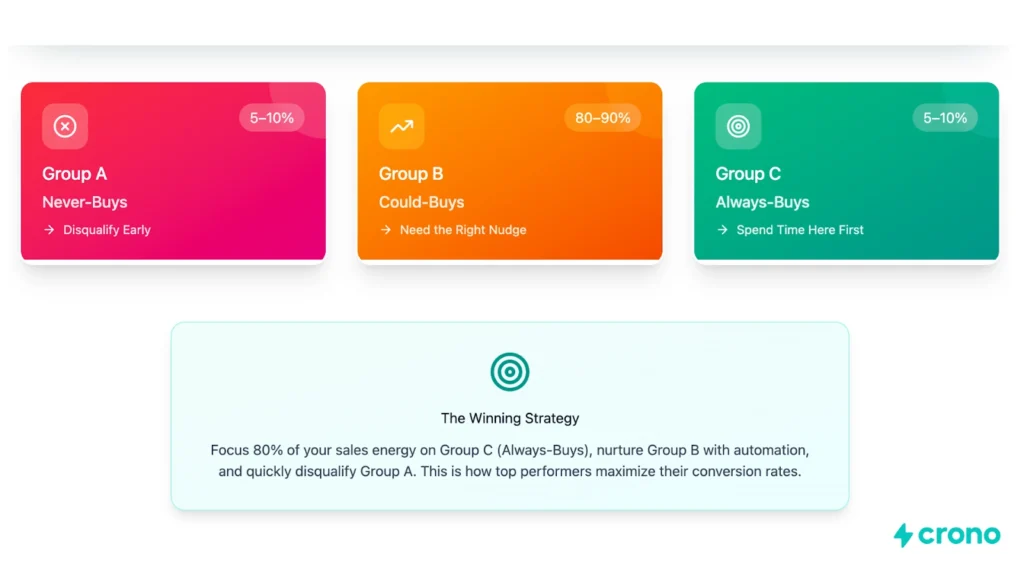
Here’s a decision matrix that could help you decide the person or organization that falls in either group:

P.S.: For more details on measuring intent, check out our guide on buying signals in sales.
Want to see prospect intent in real time?
Crono’s Live Feed lets you monitor every signal that matters — who opened your email, clicked a link, viewed your profile, or engaged with your post — all in one place.
Instead of guessing who to follow up with, your reps can see who’s showing intent right now and act immediately.
2. Messaging centered around desired outcomes, not features
For prospects to care enough to respond, your message must promise a real outcome that solves a problem they already feel.
Start by identifying the desired outcome—the tangible result your prospect wants right now. Analyze their “above-the-line problems”. These are problems that directly impact the metrics they’re accountable for. For a Head of Sales, that might be missing pipeline targets.

To uncover these business problems, follow this process:
- Look at the KPIs they’re hired to deliver. For a Head of Sales: qualified pipeline, faster deal cycles, higher conversion rates. For a CFO, predictable ROI and controlled spending.
- Identify what blocks them from hitting those targets. These are your above-the-line problems.
- Combine both to form the desired outcome.
Here’s an example:

But it’s still not enough to prompt them into action. Next, you must identify the emotional trigger you can use to communicate the desired outcome, to prompt the prospect to act.
3. Tap into both fear and logic
Buying decisions begin with emotion and are justified with logic. That means your message needs to trigger both. First, make the prospect feel the cost of inaction. Then, give them the logical proof that your solution works. For every problem you’ve identified, ask: “What happens if they don’t fix it?” to find the emotional trigger.
For example, if a Head of Sales is struggling with low outbound reply rates, their emotional driver might sound like this:
- “If I can’t prove outbound still works, leadership will cut the budget and question my ability to lead the team.”
And the logical justification could be:
- Our platform helps outbound teams increase qualified replies by 40% while keeping send volume flat — giving you measurable proof that your current headcount can still hit target pipeline goals.
Once you’ve identified the desired outcome — and the emotional and logical drivers behind it — the next step is to combine all three into a clear, relevant value proposition that feels specific, credible, and worth replying to.
4. Propose a value that aligns with the prospect’s needs
A strong value proposition connects what you offer to what your prospect actually values. It’s where the desired outcome, emotional trigger, and logical justification come together.
Your value proposition should answer three unspoken questions:
- Why me? Is this relevant to my situation?
- Why now? Why should I care today?
- Why you? Why are you the best solution?
For example, for the Head of Sales in the previous example, the value proposition could be:
- We help outbound teams prove pipeline impact to leadership by turning cold prospects into consistent, qualified replies — without increasing send volume.
After finding one contact, follow the same process to create a value proposition for each person involved in the B2B deal. This includes the end user who feels the pain, the manager or exec who wants measurable ROI, and the operations or finance stakeholder who needs reassurance of ROI.
Here are examples for the stakeholders in the buying committee for the same deal:
| Stakeholder | Problem | Desired Outcome | Emotional Justification | Logical Justification | Combined Value Proposition |
| Head of Sales | Outbound reply rates are down. | Consistent, qualified replies that prove outbound still works. | “If I can’t fix this soon, leadership will think outbound is broken and question my ability to lead.” | Teams using this approach see 40% more qualified replies without increasing send volume. | “We help outbound teams prove pipeline impact to leadership by turning cold prospects into consistent, qualified replies — without increasing volume.” |
| RevOps | We’re losing deals to faster competitors. | Shorter deal cycles and faster handoffs between SDRs and AEs. | “I’m frustrated that leads sit idle — it makes us look inefficient and hurts conversion rates.” | Real-time engagement alerts and automation reduce follow-up delays by 60%. | “We help RevOps teams create faster, cleaner handoffs so no lead slips through the cracks — helping sales close deals before competitors even respond.” |
| CFO | Sales efficiency is dropping, and costs are rising. | Predictable ROI and clear proof of outbound performance. | “If we can’t show that outbound is profitable, I’ll have to cut spending or reallocate the budget.” | Full-funnel visibility connects outbound activity directly to pipeline and revenue metrics. | “We give finance teams clarity and proof that outbound drives measurable ROI — with performance data they can trust.” |
| SDR Manager | Manual outreach is slow and inconsistent. | Less admin work, faster SDR onboarding, and better visibility into deal progress. | “My team wastes hours on repetitive tasks, and new reps take too long to ramp up.” | Automation cuts manual work by 70% and makes ramp time more predictable. | “We help SDR managers build efficient, high-performing teams with automation that removes repetitive work and speeds up onboarding.” |
One thing is clear: at the base of relevant cold outreach is finding the right details to structure your message. However, do so manually, and you’ll end up spending hours meant for other tasks on just a few prospects. That’s the essence of getting the right sales tool:
Generate Cold Outreach Results Faster with the Right Tool
The truth is, creating relevant outreach manually is brutal. By the time you’ve finished researching each prospect, the day’s almost gone — and you still haven’t followed up with the warm leads already in your pipeline.
That’s exactly why Crono’s AI feature exists. It helps you infuse relevance into thousands of prospects and outreach messages — all at once.
With just one click, Crono rewrites each message in a multichannel sequence to the context of each contact using the information you choose — like recent posts, hiring updates, funding rounds, or areas of interest.
That means you achieve relevance, but without the manual grind.
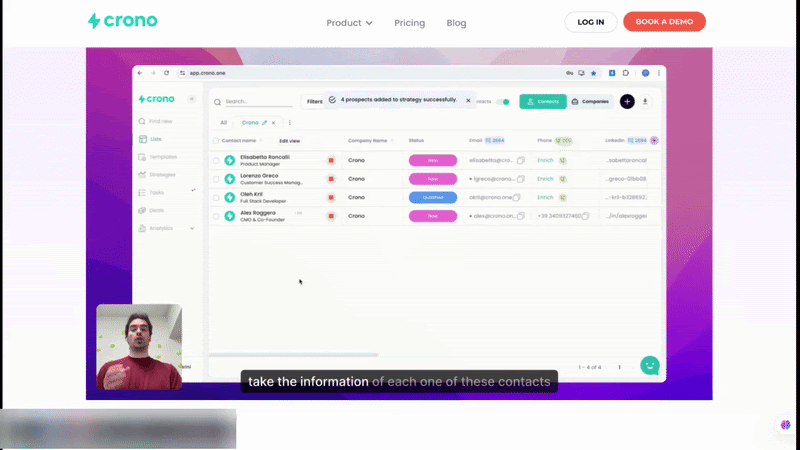
Even better, Crono lets you manage your entire sales motion in one place. With it, you can:
- Find leads using LinkedIn integration and advanced filters.
- Enrich lead lists with accurate email addresses and phone numbers you can use immediately to contact them.
- Run automated multichannel sequences across email, LinkedIn, and calls, so you easily progress prospects down the buying funnel.
- Log all sales actions automatically to your CRM, so reps don’t spend hours copying, pasting, or screenshotting interactions.
- Track all cold outreach campaigns, without switching tabs or contacting sales reps.
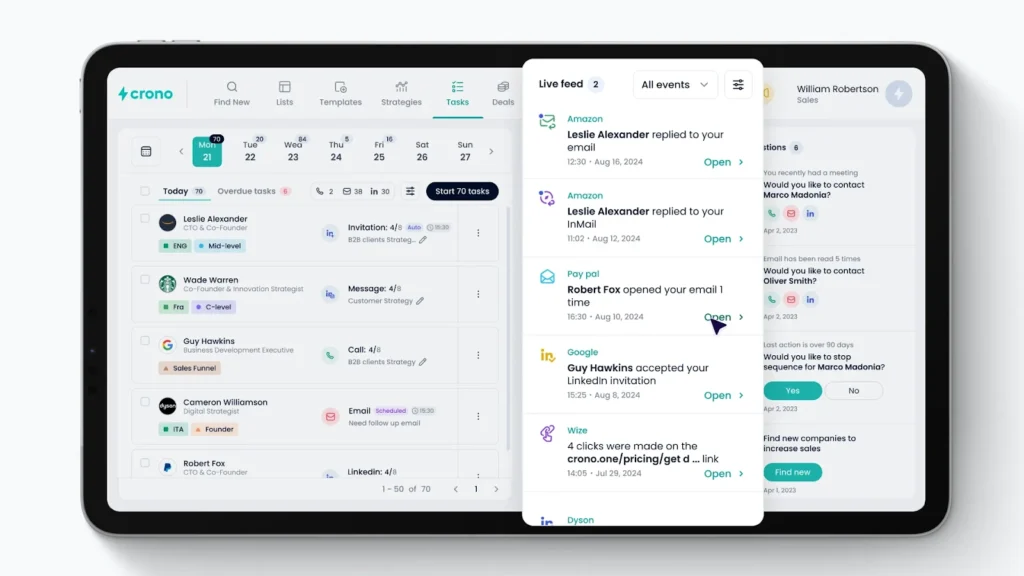
As a result, companies like Serenis scale up their relevant cold outreach campaigns and record astounding results such as:
- 19% of prospects contacted progress to a demo
- 50% LinkedIn acceptance rate
- 25% reply rate on LinkedIn messages
- 32% average email open rate
Want to achieve the same results? Book a demo to learn how Crono can help you run relevant cold outreach that generates replies and meetings.
Frequently asked questions about cold outreach strategy
Should you outsource cold outreach?
You can, but not from day one. Outsourcing works best after you’ve figured out what resonates with your market and built a repeatable process. If you outsource too early, you’ll miss learning which messaging, channels, and offers work for your specific audience.
Is cold outreach dead?
Not at all. It’s evolved. What’s dead are spray-and-pray tactics. Effective cold outreach now relies on relevance and timing. That means segmenting prospects by buying readiness, leading with outcomes (not features), using emotion and logic to inspire action, and delivering value propositions aligned with prospects’ needs.
What is cold vs warm outreach?
Cold outreach means reaching out to someone who’s never interacted with your brand. Warm outreach involves engaging prospects who’ve shown intent—by downloading a resource, attending a webinar, or requesting a quote.